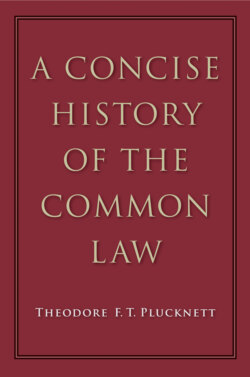Читать книгу A Concise History of the Common Law - Theodore F. T. Plucknett - Страница 148
На сайте Литреса книга снята с продажи.
THE COMMON LAW SIDE OF CHANCERY
ОглавлениеWe have said nothing so far of the Chancery.2 Its functions were in fact almost entirely secretarial in its early days, and it is not until about 1307 that we can say that it has become an independent office free from household control.3 Indeed, “office” was thought to be the most suitable word for the Chancery, as we can see from Fleta (c. 1290) who refrains from using the word “court” in this connection.4
The Chancellor was often the King’s principal adviser in political matters, but his staff was a highly specialised body of clerks. The duties of many of them were partly mechanical—copies of all important documents which passed the Great Seal were prepared upon the voluminous rolls which survive in thousands in the Public Records Office. They had also the duty of drafting and writing the original writs which were so vital to the conduct of litigation. In the early thirteenth century it would seem that they had a part to play in the formation of the common law, for it was they who sanctioned the numerous variants upon traditional forms which applicants urged them to make, and thus indirectly extended the scope of the common law. Such powers, however, were peculiar to the early formative period of the century. By its close it was already well established that the issue of a writ from the Chancery was no guarantee that the writ was valid at common law, for the judges asserted their right to quash writs which they considered unsuitable. Hence the real control over the issue of writs soon passed to the common law courts, for it was they who had the last word in sustaining or quashing the writs brought before them in litigation. The Chancery therefore exerted little influence over the creation of new writs after the thirteenth century, and the “register of writs” never became an official Chancery collection.1 It soon becomes evident that the parties themselves, or their legal advisers, draft the writs they desire, get them engrossed and sealed in the Chancery, and then support them by such arguments as they can when the time comes to plead them in the common law courts. One thing seems certain, and that is that the business of issuing writs was not the origin of either the common law or the equity jurisdiction of the Chancellor.2
Of much greater importance were the powers connected with the feudal rights of the Crown. When a tenant-in-chief died, a writ issued from Chancery to inquire by means of a jury into the lands of the late tenant and to ascertain the Crown’s rights to primer seisin, relief, the wardship of his heir if an infant, and to arrange for the dower (and sometimes the re-marriage) of his widow. Interested parties could intervene, and so a good deal of litigation arose under the head of “traverses of offices”, as these proceedings were called. Similarly, when the Crown made grants of lands or offices by letters patent, persons whose rights were affected could bring proceedings to repeal them.3 It also had important jurisdiction in petitions of right and monstrans de droit. The judges were so frequently engaged upon business of this sort in the Chancery that the Commons complained in Parliament that the courts of common law suffered considerable delays.1 These powers, which are in frequent use from the reign of Edward III onwards, are clearly derived from the administrative functions of the office, and can be compared with those of the common law side of the Exchequer with which they were in some cases concurrent. It is a difficult question how far the common law jurisdiction was an origin of the equitable jurisdiction, which may have had, in the main, a different history.2
